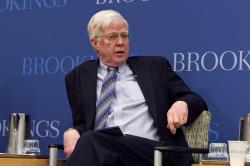The baby boom generation’s entry into retirement early in the next century will place enormous pressure on public spending in the United States. The increase in the percentage of the population that is aged will inevitably drive up the burden of paying for Social Security, Medicare, Medicaid, and other government programs. Concern over the future financing of public retirement programs has stimulated growing interest in reform. Nearly all reform proposals involve scaling back the provision of public retirement benefits. Many also entail creation or expansion of private saving mechanisms to encourage or force workers to save more for their own retirement.
As the nation considers reform options, voters and policymakers should recognize that the challenge of population aging is not unique to the United States. The jump in the aged dependency rate is actually smaller and will occur later in the United States than in other rich industrialized countries. As a result, the United States will have an opportunity to learn from the experiences of Germany, Japan, and other aging societies. Even more important, many reforms that attempt to address the problems of population aging will have substantial external repercussions in an increasingly integrated global economy. Any evaluation of reform alternatives must take account of their impact on international capital markets and trade flows. Sensible planning should also account for the impact of other countries’ reform efforts on the U.S. economy.
Countries face a choice among three broad alternatives in reforming their public retirement systems: increasing taxes to pay for a larger retired population, curtailing benefits to keep retirement programs affordable, or moving away from pay-as-you-go financing toward advance funding of future retirement obligations. The debate over the comparative merits of increasing taxes or cutting benefits is inherently divisive, because it forces generations and income classes into conflict over which group will have to make the larger sacrifice in order to maintain the solvency of the retirement system. Some of this conflict can be avoided by increasing the future national income that will finance the consumption of both workers and retirees. Advance funding is a possible way to lift future income. This alternative also holds out the promise of boosting workers’ future returns. Because a portion of future benefits will be derived from investments in the capital market, returns would not be as tightly linked to real wage increases and labor force growth as they are in the present pay-as-you-go retirement system. If real capital market returns exceed the rate of growth of real earnings, many workers would be better off under a partially or fully advance-funded retirement program than they are under a pay-as-you-go system. An advance-funded retirement system could be either public or private. In a public system the additional saving would be accumulated and managed in a large government-run retirement fund. In a private system the accumulation would occur in millions of individually owned and privately managed accounts. In either case advance funding would represent a marked departure from the current system of financing, which relies mainly on current tax payments to pay for current benefits.
In what follows we focus on the option of advance funding because it raises the most significant issues for international trade and capital flows. Any move toward advance funding must increase a nation’s saving rate in comparison with the rate that would occur under a pay-as-you-go system. Under standard neoclassical assumptions about growth in a closed economy, an increase in saving above the rate warranted by technical progress and the rate of growth of the working population must result in a decline in the rate of return on physical capital. As the rate of return falls, the advantage of advance funding over pay-as-you-go financing shrinks. The returns that savers can obtain on their domestically invested savings could fall to unacceptable levels. Faced with a sharp drop in the domestic rate of return, savers might look overseas for more attractive investment possibilities. Advance funding thus has important implications for international capital movements because the implied increase in national saving may be reflected in the buildup of large trade and current account surpluses. In this paper we examine this set of issues within the context of a standard neoclassical growth model.
Our paper is divided into five main parts. The next section offers a brief overview of demographic trends and pension costs in the major industrialized countries’ economies. It is followed by a detailed description of the projected costs associated with population aging in the United States. The third section examines the implications of demographic change for the balance of national saving and investment, assuming that saving is domestically invested. Although the higher future costs connected with population aging could be covered by an increase in saving, the higher saving would occur at a time of substantial slowing in labor force growth and, hence, in domestic demand for capital. As a result, the benefits of increased saving would be partially offset by a falling rate of return on capital. The final section of the paper explores the option of investing extra saving in a wider global economy as a means of moderating the decline in the return to capital.



